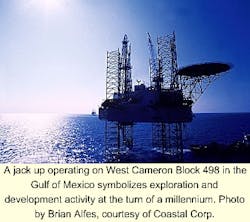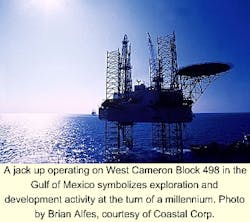E&D organizations face people, data operating issues
Exploration and development organizations enter a new millennium with unprecedented amounts of subsurface and surface data, experienced if aging geoscience staffs, impressive drilling opportunities, and a daunting array of responsibilities to their employers and shareholders.
The oil and gas industry has held onto its position, established early in the second half of the closing millennium, as one of the largest users of computer power. It consumes so much data, though, that time spent sorting data takes a disproportionate share of the work day.
Wrenching restructuring has transcended both negative and positive economic cycles, flinging even learned geoscientists from one organization to another. Those who have hung on to oil and gas work have pushed the average age of the salaried community into the 50s, and the industry economic upheaval of the last 2 decades has painted a career portrait to which relatively few aspire.
With fewer organizations prospecting overall with fewer dollars, countries have sweetened fiscal terms and opened more acreage to compete. Blocks the size of small countries have been offered for exploration, and for a few years it almost seemed that so much acreage that contained exploitation potential became available that exploration could take a holiday.
That scenario could not last. Low prices feed rising demand which depletes reserves which stimulates pricesellipseand the incentive to explore quickly returns. At $25-30/bbl and $3-8/Mcf, arguably most of the people in the world who know how to explore and develop and who want to work are trying to find and extract every barrel in their power.
This essay is an attempt to list some of the issues that face E&D organizations.
Explosion of data
Computer hardware and software developments since the 1970s have made accessible a staggering volume of data that is both a boon to exploration and development processes and a challenge to manage.
While geoscientists deal with the exponential increases in data volume, they and their managers-and vendors-are exploring for more ways to reduce the still significant amount of time they spend searching for data as opposed to using them to find more oil and gas.
The amount of data in a large seismic survey, a few hundred megabytes in the early 1990s, can be in the tens of gigabytes today. Yet consensus remains that a given volume of seismic data contains significant amounts of potentially valuable information that cannot yet be accessed.
Another information issue involves suitable hard data storage capacity and who will pay to house the avalanche of cores, samples, and logs accumulated since the end of the previous century. Much of the mass stands to be lost unless a solution is found soon.
E-commerce is an approaching force. Exploration blocks and drilling prospects are offered on the worldwide web.
Literature holds that most exploration people are objective optimists, but some are notable for data they choose not to examine. Some still take delight in rejecting new and less-tried prospecting methods and techniques.
Some ideas and methods initially perceived earlier in the century as possible threats to geology and geophysics have not proved to be so.
Geophysical, other data
The data explosion that has challenged explorers' efforts to keep pace may have fallen behind drilling activity.
Analysts offered the idea that seismic activity, long considered a leading indicator of drilling trends, has begun to lag drilling because faster acquisition and processing have created a backlog of drillable prospects, at least in the US (OGJ, Dec. 4, 2000, Newsletter, p. 7).
During low-price periods beginning in the mid-1980s, seismic companies assigned a limited number of crews that lacked contract work to acquire seismic data for their own spec data libraries. This drove seismic costs down and made data more widely available.
Greater efficiency of processing and reprocessing has given operators more prospects per seismic crew and afforded more companies access to 3D seismic data at lower costs. With higher oil and gas prices in 2000-01, the reasoning goes, drilling activity will work off the prospect glut and seismic activity should rebound later this year.
Meanwhile, the spec seismic drive that began as a trickle began to dominate the business later in the 1990s with massive industry consolidations. This raised serious data ownership and confidentiality issues.
Nongeophysical data also beg for attention.
Most of the earth is covered by underused sets of nonseismic data of varying quality and resolution, according to a paper prepared for delivery at a large industry meeting in late 2000. These include gravity, magnetics, radiometrics, bathymetry, topography, remote sensing data, geological maps, outcrop locations, mineral exploration knowledge, and other airborne and surface-derived data sets.
The authors concluded that systematic, phased acquisition, processing, and calibration of high spatial-resolution nonseismic data sets with 2D and 3D seismic data will generally result in either significant savings in seismic acquisition costs or focus higher-density seismic acquisition on more-prospective locations earlier in an exploration program.
People and their uses
An exploration sage said oil and gas are first found in peoples' minds, but first we have to have the people.
Conventional wisdom holds that the average age of world's employed geoscientists is more than 50 years.
According to a salary survey conducted for the American Association of Petroleum Geologists, extended periods of low oil and gas prices resulted in a near absence of entry-level hiring of petroleum geologists in the 1990s.
One outcome: In the 1999 installment of the salary survey, more than 50% of those sampled had 20 or more years of experience, another 25% had 15-19 years, and fewer than 15% had less than 10 years.
During 1999, part of one of those low-price periods, those with 20 years or more reported a practically flat salary rate compared with 1998. Worse, the survey showed that the average pay for all petroleum geologists increased less than 4% in 1999 as brisk merger and acquisition activity made for a stagnant job market.
The survey firm looked only at employed geologists with salaried jobs and did not consider any other benefits such as consulting fees, retainers, or overrides. Those surveyed said that companies were far too specific in job descriptions and na
Then came the year 2000 and $20-30/bbl oil, and the situation seems to have changed rapidly. Now some companies report paying bonuses and adding perquisites to stall the hiring away of valued hands.
The average age of geoscience workers has made an important issue of how to pass to younger exploration people large amounts of expensively gotten experience and expertise. The crush to practice their trade leaves the seasoned folks little time to pass it on, and of course first someone has to be there to listen.
Attracting young people to the industry and cross-discipline training have become two large educational issues.
A world to be explored
That portion of the world that is open to exploration seems to have grown markedly during the past decade.
Vast areas of the former Soviet bloc, China, Venezuela, Brazil, India, and even the Middle East have opened up.
Closed and disputed territories have given way to joint development areas and zones of cooperation. Some problem areas remain, and almost every continent has its examples.
Fiscal systems are under constant adjustment to fit economic realities and attract exploration interest-and capital.
Risk-taking organizations are penetrating former frontiers, such as deepwater exploration, fractured shales, basin-centered gas deposits, and gas hydrates.
Still, basins unexplored and underexplored with modern technology are almost everywhere.
Ironically, as much of the world opened to exploration, lockups, bans, and drilling moratoriums have been imposed on numerous areas thought prospective. Each well control problem, pipeline break, tanker discharge, or other spill elicits regulatory sprawl, and urban sprawl challenges drilling and production operators to find new ways to coexist.
The business side
Public companies, especially in North America, face enormous pressures to replace production and build their reserves in order to add value for shareholders, but even those that succeed often end up on merger-and-acquisition alley.
Stability in oil and gas prices has been elusive, and chances are it will remain so because prices are subject to too many unpredictable economic and political forces.
High oil and gas prices do serve some useful functions. They elicit at least short-term production spikes. They act as a temporary replacement for access to capital. They draw experienced, laid-off personnel back into the business.
Unfortunately, they can also relieve pressure on organizations to minimize finding costs. Competitive forces will leave little room for that.
In spite of recent price levels, some organizations are still struggling to survive the low prices of 1998-99.
Whatever the circumstances, exploration and development drilling continue, the American Petroleum Institute points out, in light of some of history's highest drilling and completion costs, offshore and onshore, experienced in calendar 1999. These have occurred in concert with higher royalties paid, higher permitting fees, and other operating obstacles.
The industry's players must find their niches in a global industry while increasing respect for environmental concerns.
Large professional associations and societies have discussed business consolidations as their member geologists, geophysicists, and engineers explored the advantages of integrating their personal expertise.
Are oil and gas, the world's most sought energy sources, at the pinnacle of their plenty? We are told this is in dispute, but year after year we produce more oil and somehow find a little more than that. Each succeeding resource estimate identifies a greater target than the last, and technology and ingenuity convert a little more of the figment into recoverable hydrocarbons.

